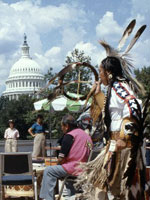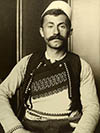1. Who was the first Irish American to run for president?
b. Alfred Emmanuel Smith, Jr.
 In 1928, Alfred Emmanuel Smith, Jr., four times governor of New York, ran as the Democratic candidate for president of the U.S.. Though "Al" Smith's heritage also included German, Italian, and English ancestry, he identified as Irish American, and faced prejudice for both his ethnicity and his religion (he was Catholic) during his campaign. The press and the public suspected him of drunkenness (stereotypically associated with Irish Americans), manipulation by the Pope, and involvement with Tammany Hall (a New York City Democratic political machine known for supporting Irish Americans in politics).
In 1928, Alfred Emmanuel Smith, Jr., four times governor of New York, ran as the Democratic candidate for president of the U.S.. Though "Al" Smith's heritage also included German, Italian, and English ancestry, he identified as Irish American, and faced prejudice for both his ethnicity and his religion (he was Catholic) during his campaign. The press and the public suspected him of drunkenness (stereotypically associated with Irish Americans), manipulation by the Pope, and involvement with Tammany Hall (a New York City Democratic political machine known for supporting Irish Americans in politics).
Smith lost the election to Herbert Hoover, but he went on to become president of Empire State, Inc.—the company that built the Empire State Building.
2. Which of the following men with Irish ancestry was known as "father" of a branch of the U.S. military?
a. John Barry, naval officer in the American Revolution
 Irish-born John Barry first crisscrossed the Atlantic as a respected commander of merchant ships—but when war broke out with England, he joined the Continental Army and was commissioned a naval captain in 1776. (He also served in several battles on land, while a ship he was to command, the Effington, was under construction.) Though he gained fame for valor and loyalty during the war, he returned to captaining merchant ships when it concluded.
Irish-born John Barry first crisscrossed the Atlantic as a respected commander of merchant ships—but when war broke out with England, he joined the Continental Army and was commissioned a naval captain in 1776. (He also served in several battles on land, while a ship he was to command, the Effington, was under construction.) Though he gained fame for valor and loyalty during the war, he returned to captaining merchant ships when it concluded.
However, in 1794, some time after the establishment of the U.S. Navy, President George Washington chose Barry as senior Captain of the Federal Navy. Barry saw active service until 1801, and trained many of the naval officers who would serve in the War of 1812. He was referred to as "Father of the U.S. Navy" in his own time.
3. Which famous survivor of the Titanic's sinking was Irish American?
d. Margaret Brown, activist and socialite
 The daughter of Irish immigrants, Margaret Brown rose into high-society circles when her husband, James Joseph Brown, became a board member of the Ibex Mining Company. She used her new social status to advocate for the rights of women and children—activities which she continued throughout her life. Her status also allowed her to board the Titanic as a first-class passenger; she earned fame and the nickname "The Unsinkable Molly Brown" for her efforts to get passengers into lifeboats and to bring her own lifeboat around to look for survivors.
The daughter of Irish immigrants, Margaret Brown rose into high-society circles when her husband, James Joseph Brown, became a board member of the Ibex Mining Company. She used her new social status to advocate for the rights of women and children—activities which she continued throughout her life. Her status also allowed her to board the Titanic as a first-class passenger; she earned fame and the nickname "The Unsinkable Molly Brown" for her efforts to get passengers into lifeboats and to bring her own lifeboat around to look for survivors.
4. Which of these women of Irish ancestry helped found the Industrial Workers of the World, a major (and still existing) labor union?
a. Mary Harris Jones
 Mary Harris Jones, also known as "Mother Jones," participated in the founding of the Industrial Workers of the World (IWW) in 1905. Jones, who was born in Ireland and grew up in the U.S., took a leading role in the early-20th-century labor movement following the death of her husband and four children in a yellow fever epidemic and the later loss of her dressmaking shop in the Great Chicago Fire. Arrested multiple times, she gained notoriety across the country as a labor organizer, motivating women and children to participate in strikes in support of their husbands and fathers. She also organized children to strike for their own rights—in 1903, child mill and mine workers marched in Jones's "Children's Crusade," helping to bring child labor to public attention.
Mary Harris Jones, also known as "Mother Jones," participated in the founding of the Industrial Workers of the World (IWW) in 1905. Jones, who was born in Ireland and grew up in the U.S., took a leading role in the early-20th-century labor movement following the death of her husband and four children in a yellow fever epidemic and the later loss of her dressmaking shop in the Great Chicago Fire. Arrested multiple times, she gained notoriety across the country as a labor organizer, motivating women and children to participate in strikes in support of their husbands and fathers. She also organized children to strike for their own rights—in 1903, child mill and mine workers marched in Jones's "Children's Crusade," helping to bring child labor to public attention.
Jones remained active in labor organization until her death in 1930, when she was over 90 years old.
 In 1928, Alfred Emmanuel Smith, Jr., four times governor of New York, ran as the Democratic candidate for president of the U.S.. Though "Al" Smith's heritage also included German, Italian, and English ancestry, he identified as Irish American, and faced prejudice for both his ethnicity and his religion (he was Catholic) during his campaign. The press and the public suspected him of drunkenness (stereotypically associated with Irish Americans), manipulation by the Pope, and involvement with Tammany Hall (a New York City Democratic political machine known for supporting Irish Americans in politics).
In 1928, Alfred Emmanuel Smith, Jr., four times governor of New York, ran as the Democratic candidate for president of the U.S.. Though "Al" Smith's heritage also included German, Italian, and English ancestry, he identified as Irish American, and faced prejudice for both his ethnicity and his religion (he was Catholic) during his campaign. The press and the public suspected him of drunkenness (stereotypically associated with Irish Americans), manipulation by the Pope, and involvement with Tammany Hall (a New York City Democratic political machine known for supporting Irish Americans in politics). Irish-born John Barry first crisscrossed the Atlantic as a respected commander of merchant ships—but when war broke out with England, he joined the Continental Army and was commissioned a naval captain in 1776. (He also served in several battles on land, while a ship he was to command, the Effington, was under construction.) Though he gained fame for valor and loyalty during the war, he returned to captaining merchant ships when it concluded.
Irish-born John Barry first crisscrossed the Atlantic as a respected commander of merchant ships—but when war broke out with England, he joined the Continental Army and was commissioned a naval captain in 1776. (He also served in several battles on land, while a ship he was to command, the Effington, was under construction.) Though he gained fame for valor and loyalty during the war, he returned to captaining merchant ships when it concluded. The daughter of Irish immigrants, Margaret Brown rose into high-society circles when her husband, James Joseph Brown, became a board member of the Ibex Mining Company. She used her new social status to advocate for the rights of women and children—activities which she continued throughout her life. Her status also allowed her to board the Titanic as a first-class passenger; she earned fame and the nickname "The Unsinkable Molly Brown" for her efforts to get passengers into lifeboats and to bring her own lifeboat around to look for survivors.
The daughter of Irish immigrants, Margaret Brown rose into high-society circles when her husband, James Joseph Brown, became a board member of the Ibex Mining Company. She used her new social status to advocate for the rights of women and children—activities which she continued throughout her life. Her status also allowed her to board the Titanic as a first-class passenger; she earned fame and the nickname "The Unsinkable Molly Brown" for her efforts to get passengers into lifeboats and to bring her own lifeboat around to look for survivors. Mary Harris Jones, also known as "Mother Jones," participated in the founding of the Industrial Workers of the World (IWW) in 1905. Jones, who was born in Ireland and grew up in the U.S., took a leading role in the early-20th-century labor movement following the death of her husband and four children in a yellow fever epidemic and the later loss of her dressmaking shop in the Great Chicago Fire. Arrested multiple times, she gained notoriety across the country as a labor organizer, motivating women and children to participate in strikes in support of their husbands and fathers. She also organized children to strike for their own rights—in 1903, child mill and mine workers marched in Jones's "Children's Crusade," helping to bring child labor to public attention.
Mary Harris Jones, also known as "Mother Jones," participated in the founding of the Industrial Workers of the World (IWW) in 1905. Jones, who was born in Ireland and grew up in the U.S., took a leading role in the early-20th-century labor movement following the death of her husband and four children in a yellow fever epidemic and the later loss of her dressmaking shop in the Great Chicago Fire. Arrested multiple times, she gained notoriety across the country as a labor organizer, motivating women and children to participate in strikes in support of their husbands and fathers. She also organized children to strike for their own rights—in 1903, child mill and mine workers marched in Jones's "Children's Crusade," helping to bring child labor to public attention.














